

Open Annotation Collaborative. Text mining. Databib. Welcome // VisualEyes. Functional Objectives. November 5, 2010 Functional Objectives – Short-term Page turner mechanism: HathiTrust supports an application for reading, downloading, and interacting with (e.g., zooming and rotating) texts and images in HathiTrust.
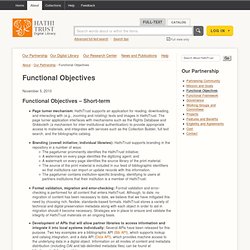
The page turner application interfaces with mechanisms such as the Rights Database and Shibboleth (a mechanism for inter-institutional authentication) to provide appropriate access to materials, and integrates with services such as the Collection Builder, full text search, and the bibliographic catalog. Branding (overall initiative; individual libraries): HathiTrust supports branding in the repository in a number of ways: The pageturner prominently identifies the HathiTrust initiative; A watermark on every page identifies the digitizing agent; and A watermark on every page identifies the source library of the print material.
Functional Objectives – Long-term 1. 2. 3. Collections.
REED Resources. REED has now moved into the electronic era in a dynamic, educationally exciting ways.

All our websites are made freely available in order to reach the widest group of users. Early Modern London Theatres Launched on 1 February 2011 at Shakespeare's Globe in London, Early Modern London Theatres (EMLoT) is an open-access research database and educational resource that focuses, in its first phase, on eight theatres north of the Thames. EMLoT results from a collaboration between REED, the Department of Digital Humanities (DDH) at King's College London, and the Department of English at the University of Southampton. Co-directors for the first stage of development have been Sally-Beth MacLean, Director of Research, REED, and John McGavin, Professor of English, University of Southampton with John Bradley, Senior Research Analyst, DDH, as technical director.
A special feature is the Learning Zone for high school and university teachers and students. Digital Curation and Preservation Bibliography. From Archive to Researcher: a Generic Tool Set. There were two major aims in the LEADERS (Linking EAD to Electronically Retrievable Sources) project: 1.To carry out research on the needs of users of archive and records collections 2.To develop a toolset to deliver finding aids, transcriptions and digital images of archives over the Internet The Internet makes it possible for finding aids (metadata about archives) to be accessed electronically, most often using the Encoded Archival Description (EAD), a standard for electronic finding aids.
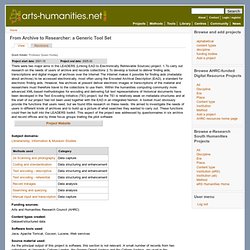
However, few archives at present deliver electronic images or transcriptions of the material and researchers must therefore travel to the collections to use them. Funding sources: Arts and Humanities Research Council (AHRC) Content types created: Dataset/structured data Software tools used: Java, Apache Tomcat, Cocoon, Lucene, Web services Source material used: As the principal output of this project is software, this section is not relevant. Digital resource created: Arts and Humanities Data Service. AHDS Projects and Method Database (prototype) - PROJECT COMPLETED Description | Outcomes | Project Details and Contacts| Documents The objective of the project "AHDS Projects and Method Database (prototype)" is to establish a pilot database recording information on current and recent ICT-based research in the arts and humanities across the UK.
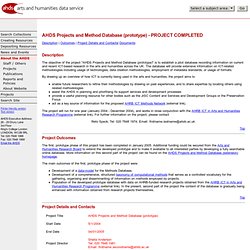
The database will provide extensive information on ICT-related methodologies including usage of technologies, data creation methodologies, employment of metadata standards, or usage of formats. By drawing up an overview of how ICT is currently being used in the arts and humanities, the project aims to. Methods. Project Blogs. Omeka. Ngram Viewer. TEI by example. PressForward. Centrum voor Teksteditie en Bronnenstudie - TEI by example. In zowat alle projecten die digitaal worden opgevat, maakt het CTB gebruik van een codering die gebaseerd is op de Guidelines for Electronic Text Encoding and Interchange van het TEI Consortium.
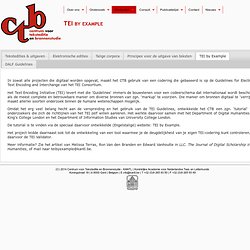
Het Text Encoding Initiative (TEI) levert met die 'Guidelines' immers de bouwstenen voor een codeerschema dat internationaal wordt beschouwd als de meest complete en betrouwbare manier om diverse bronnen van zgn. 'markup' te voorzien. Die manier om bronnen digitaal te 'verrijken' maakt allerlei soorten onderzoek binnen de humane wetenschappen mogelijk. Omdat het erg veel belang hecht aan de verspreiding en het gebruik van de TEI Guidelines, ontwikkelde het CTB een zgn. 'tutorial' voor onderzoekers die zich de richtlijnen van het TEI zelf willen aanleren. The DM Project.
The DM project is pleased to announce that it has been awarded a Digital Humanities Implementation Grant for 2013-14 by the National Endowment for the Humanities.
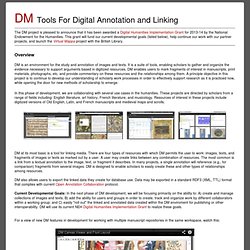
This grant will fund our current developmental goals (listed below), help continue our work with our partner projects, and launch the Virtual Mappa project with the British Library. Overview DM is an environment for the study and annotation of images and texts. It is a suite of tools, enabling scholars to gather and organize the evidence necessary to support arguments based in digitized resources. DM enables users to mark fragments of interest in manuscripts, print materials, photographs, etc. and provide commentary on these resources and the relationships among them.
In this phase of development, we are collaborating with several use cases in the humanities. DM at its most basic is a tool for linking media. DM also allows users to export the linked data they create for database use. Use Cases Funding History. A Digital Helping Hand for Scholarly Work.